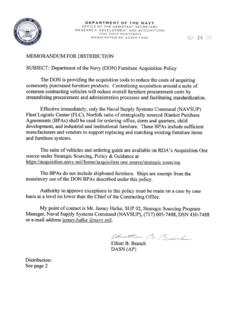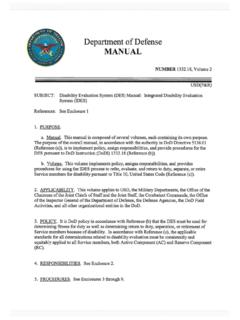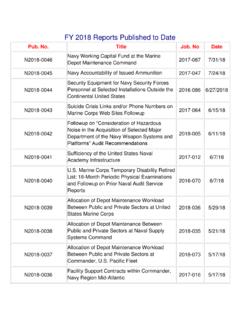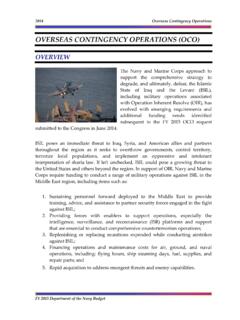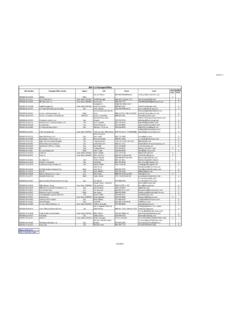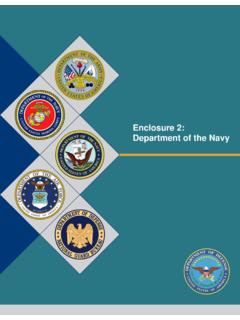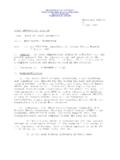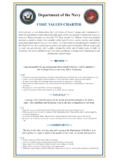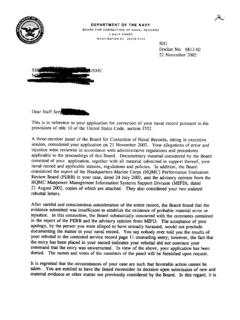Transcription of DEPARTMENT OF THE NAVY - United States Navy
1 DEPARTMENT OF THE navy NAVAL INSPECTOR GENERAL 1254 9TH STREET SE WASHINGTON navy YARD, DC 20374-5006 From: Naval Inspector General To: Distribution IN REPLY REFER TO: 5040 Ser N3/1069 13 Oct 15 Subj: COMMAND INSPECTION OF COMMANDER, NAVAL FORCES SOUTHERN COMMAND/COMMANDER, FOURTH FLEET, 18-26 JUNE 2015 Ref: (a) SECNA VINST (b) SECNA VINST 1. The Naval Inspector General (NAVINSGEN) conducts command inspections of echelon 2 commands to provide the Secretary of the navy and the Chief of Naval Operations with a firsthand assessment of Departmental risks and major issues relevant to policy, management, and direction as directed by reference (a). Reference (b) tasks NAVINSGEN with conducting inspections and surveys, making appropriate evaluations and recommendations concerning operating forces afloat and ashore, DEPARTMENT of the navy components and functions, and navy programs which impact readiness or quality of life for military and civilian naval personnel.
2 2. NAVINSGEN conducted a Command Inspection of Commander, Naval Forces Southern Command (COMUSNAVSO)/Commander, Fourth Fleet (C4F) from 18-26 June 2015. This report documents our findings. 3. This report contains an Executive Summary, our observations and findings, and documented deficiencies noted during the inspection. A summary of survey and focus group data, as well as a complete listing of survey frequency data, is included. 4. During our visit we assessed overall mission readiness in execution of its echelon 2 responsibilities per OPNA VINST , Mission, Functions, and Tasks of Commander, Naval Forces Southern Command/Commander, Fourth Fleet Mayport, Florida (8 September 2011), and other laws, policy, and regulations.
3 We assessed compliance with navy administrative programs; facilities, safety and environmental compliance; security programs, Inspector General functions, and Sailor programs under the purview of senior enlisted leadership. Additionally, we conducted surveys and focus group discussions to assess the quality of work life (QOWL) and home life (QOHL) for navy military and civilian personnel. 5. Our overall assessment is that COMUSNAVSO/C4F is maturing as an organization. We found a highly motivated team, with an aggressive, can-do culture enabling the command to accomplish their assigned tasks and missions with limited resources. COMUSNA VSO/C4F is challenged to meet presence requirements because of lower priority Global Force Management sourcing based on higher Force Allocation Decision Model priorities, the decommissioning of Oliver Hazard Perry-class Frigates (FFGs) frequently assigned to SOUTHCOM AOR missions, b7cb7cSubj: COMMAND INSPECTION OF COMMANDER, NAVAL FORCES SOUTHERN COMMAND/COMMANDER, FOURTH FLEET, 18-26 JUNE 2015 Distribution.
4 (Cont' d) NCIS CNO VCNO OPNAV (DNS, N1, N2/N6, N3/N5, N4, N46) USFF CPF BUPERS FLTCYBERCOM 3 FOR OFFICIAL USE ONLY NAVAL INSPECTOR GENERAL COMMAND INSPECTION OF COMMANDER, NAVAL FORCES SOUTHERN COMMAND/COMMANDER, FOURTH FLEET 18 26 JUNE 2015 THIS REPORT IS NOT RELEASABLE without the specific approval of the Secretary of the navy . The information contained herein relates to the internal practices of the DEPARTMENT of the navy (DON) and is an internal communication within the navy DEPARTMENT . The contents may not be disclosed outside original distribution, nor may it be reproduced in whole or in part. All requests for this report, extracts therefrom, or correspondence related thereto shall be referred to the Naval Inspector General.
5 FOR OFFICIAL USE ONLY i Executive Summary The Naval Inspector General (NAVINSGEN) conducted a command inspection of Commander, Naval Forces Southern Command/Commander, Fourth Fleet (USNAVSO/C4F) from 18 - 26 June 2015. This was the command s first inspection since USNAVSO was realigned from an echelon 3 to an echelon 2 command in 2008. We conducted a Command Health and Comfort Review in May, 2011, during which we determined USNAVSO to be well organized and compliant with navy programs and directives. For the current inspection, the team was augmented with subject matter experts, including personnel from the Deputy Under Secretary of the navy (Policy) (DUSN(P)), Assistant Secretary of the navy ( Financial Management and Comptroller) (ASN(FM&C)), Office of the Chief of Naval Operations for Information Dominance/Naval Intelligence (OPNAV N2/N6); Commander, Fleet Forces Command (USFF); Commander, Naval Air Force Atlantic (CNAL); Naval Facilities Engineering Command (NAVFAC); Naval Safety Center (NAVSAFECEN); Naval Criminal Investigative Service (NCIS) Security Training Assistance and Assessment Team (STAAT); and the Office of Civilian Human Resources (OCHR).
6 The USNAVSO/C4F, hereafter referred to as USNAVSO, mission statement is to employ maritime forces in cooperative maritime security operations in order to maintain access, enhance interoperability, and build enduring partnerships that foster regional security in the Southern Command (USSOUTHCOM) Area of Responsibility (AOR). USNAVSO has three lines of operation ( Maritime Security Operations, Security Cooperation Activities, and Contingency Operations) and four lines of effort ( Counter Illicit Trafficking (CIT), Southern Seas, Continuing Promise, and Southern Partnership Station). During our visit we assessed overall mission readiness in execution of its echelon 2 responsibilities per OPNAVINST , Missions, Functions and Tasks of Commander, Naval Forces Southern Command and Commander, Fourth Fleet, Mayport, Florida; United States Southern Commander Memorandum of July 16, 2015, Subj: Approval of the Revised Mission Essential Task List for USSOUTHCOM Component Commands and Joint Task Forces; and OPNAVINST , Defense Readiness Reporting System- navy ; and other laws, policies, and regulations.
7 We assessed administrative programs, facilities, safety and environmental compliance, security programs, and Sailor programs under the purview of senior enlisted leadership. Additionally, we conducted surveys and focus group discussions to assess the quality of work life (QOWL) and home life (QOHL) for navy military and civilian personnel. MISSION READINESS Mission Performance USNAVSO is executing its naval component commander duties for USSOUTHCOM with flat or declining resources. As a relatively new echelon 2 command, USNAVSO continues to mature as an organization. There is an established culture of mission accomplishment with an aggressive, can do attitude. USNAVSO is challenged to meet presence requirements with limited FOR OFFICIAL USE ONLY ii assigned forces and minimal likelihood of relief through the Global Force Management (GFM) process given higher Force Allocation Decision Model priorities in other AORs.
8 The GFM process has consistently been unable to meet Joint Interagency Task Force South surface presence requirements in support of the CIT mission. When available, the decommissioning Oliver Hazard Perry-class Frigate (FFG) has been the platform of choice to meet these requirements. We are concerned that the potential replacement platforms for the decommissioning FFGs, such as Patrol Coastal boats, Joint High Speed Vessels, and Littoral Combat Ships may not provide the same capabilities. We observed two primary USNAVSO methods for mitigating GFM gaps: the use of pre-commissioning units and units undergoing a homeport shift transiting through the USNAVSO AOR. Additionally, the pursuit of science and technology projects has established the USNAVSO AOR as a Theater of Innovation.
9 Further, we observed effective integration with USSOUTHCOM and interagency coordination and assessed USNAVSO use of the USSOUTHCOM Theater Security Cooperation Management Information System (TSCMIS) to track, plan, and map engagements to desired effects as a best practice. Beyond TSCMIS, USNAVSO lacks a formal operational assessment program and has suboptimal knowledge retention. Maritime Operations Center (MOC) The USNAVSO MOC is operated in accordance with NTTP 3-3 , Maritime Operations Center, but is not yet compliant with OPNAVINST , Maritime Operations Center Standardization. The purpose of the MOC Standard is to (1) define the overarching mission, functions, and tasks of the MOC within the fleet headquarters construct to employ the total navy force (Active component, Reserve component, and civilian component); (2) identify the expected workload, capability, and capacity of the navy s operational level headquarters warfighting element; (3) align operational level and tactical level headquarters organizations, people, materiel, procedures, and proficiency expectations; and (4) provide a basis for leadership to prioritize and resource the MOC in a more holistic fashion.
10 Use of this instruction will assist USNAVSO to assess current MOC manning and clarify its ability to meet its mission. Missions, Functions, and Tasks (MFT) The USNAVSO MFTs are delineated in OPNAVINST The USNAVSO MFT, approved in September 2011, is out of date. Echelon 2 shore activity commanders are required to submit an updated MFT statement, as needed, and at least every three years. Shore Manpower Requirements Determination (SMRD) USNAVSO is not in compliance with OPNAVINST CH-1, navy Total Force Manpower Policies and Procedures, and requires an SMRD. The last approved SMRD for USNAVSO occurred prior to the re-establishment of Fourth Fleet (and associated dual-hatting of COMUSNAVSO and C4F) in 2008, and MFT publication in 2011.
